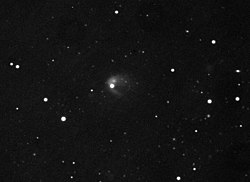(596) Scheila
|
Asteroid (596) Scheila |
|
|---|---|

|
|
| Scheila with dust ejection on December 12, 2010 | |
| Properties of the orbit ( animation ) | |
| Orbit type | Main belt asteroid |
| Major semi-axis | 2.927 AU |
| eccentricity | 0.1653 |
| Perihelion - aphelion | 2,443 AU - 3,410 AU |
| Inclination of the orbit plane | 14.66 ° |
| Length of the ascending node | 70.7 ° |
| Argument of the periapsis | 176.0 ° |
| Time of passage of the perihelion | May 19, 2012 |
| Sidereal period | 5 a 2 d |
| Mean orbital velocity | 17.3 km / s |
| Physical Properties | |
| Medium diameter | approx. 113 km |
| Albedo | 0.04 |
| Absolute brightness | 8.9 likes |
| Spectral class | T (SMASS) |
| history | |
| Explorer | August Kopff |
| Date of discovery | February 21, 1906 |
| Another name | 1906 UA, 1949 WT |
| Source: Unless otherwise stated, the data comes from JPL Small-Body Database Browser . The affiliation to an asteroid family is automatically determined from the AstDyS-2 database . Please also note the note on asteroid items. | |
(596) Scheila is an asteroid of the main belt that was discovered by August Kopff in Heidelberg on February 21, 1906 .
The asteroid bears the name of an English student at the University of Heidelberg , with whom the discoverer was friends.
On December 11, 2010, Steve Larson discovered a tail similar to the coma of a comet with a brightness of about 13.5 mag as part of the Catalina Sky Survey . After looking through the archive material, the appearance of the publication could be narrowed down to the period between November 11th and December 3rd, 2010. Images from the 2 m telescope Faulkes Telescope North on Hawaii show a tail pointing away from the sun and another tail in the direction of the orbit.
Initially, it could not be ruled out that Scheila was not an asteroid, but a comet that was previously "sleeping". In investigations with the Hubble Space Telescope and the UV-Optical Telescope (UVOT) of the Swift satellite , no gases typical of comets could be detected. Therefore it now seems most likely that the tails are the result of an impact at about 5 km / s through another body about 35 m in diameter.
See also
Individual evidence
- ↑ Ernesto Guido & Giovanni Sostero: Comet-like appearance of (596) Scheila . Remanzacco Observatory in Italy (blog). December 12, 2010. Retrieved December 12, 2010.
- ↑ Mike Simonsen: A Comet Masquerading as an Asteroid . Simostronomy (blog). December 12, 2010. Retrieved December 12, 2010.
- ↑ Richard Miles's posting on Yahoo minor planet mailing list (MPML)
- ↑ David Jewitt, Weaver, H .; Mutcher, M .; Larson, S .; Agarwal, J .: Hubble Space Telescope Observations of Main Belt Comet (596) Scheila . In: ApJL . 2011. arxiv : 1103.5456 . bibcode : 2011arXiv1103.5456J .
- ↑ Dennis Bodewits, Kelley, MS; Li, J.-Y .; Landsman, WB; Besse, S .; A'Hearn, MF: Collisional Excavation of Asteroid (596) Scheila . In: accepted for publication by ApJ letters . 2011. arxiv : 1104.5227 .